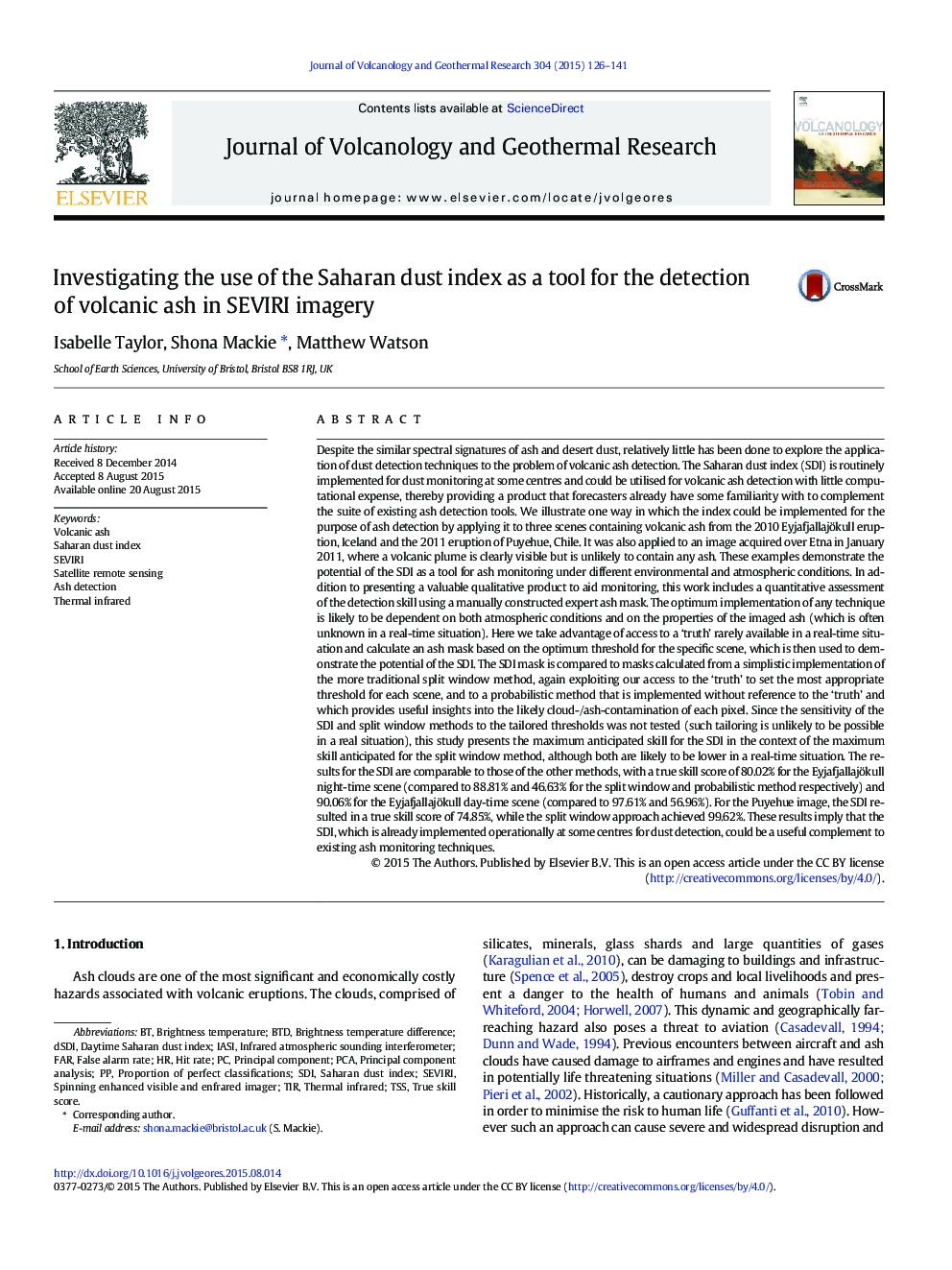| کد مقاله | کد نشریه | سال انتشار | مقاله انگلیسی | نسخه تمام متن |
|---|---|---|---|---|
| 6439790 | 1638318 | 2015 | 16 صفحه PDF | دانلود رایگان |
عنوان انگلیسی مقاله ISI
Investigating the use of the Saharan dust index as a tool for the detection of volcanic ash in SEVIRI imagery
دانلود مقاله + سفارش ترجمه
دانلود مقاله ISI انگلیسی
رایگان برای ایرانیان
کلمات کلیدی
IASIBrightness temperature differenceBTDSDITSSPCA - PCAHit rate - آمار نرخFAR - بعداPrincipal component analysis - تحلیل مولفههای اصلی یا PCATIR - تیرVolcanic ash - خاکستر آتشفشانیbrightness temperature - دمای روشناییSatellite remote sensing - سنجش از راه دور ماهواره ایSEVIRI - عاشقThermal infrared - مادون قرمز حرارتیprincipal component - مولفه های اصلیFalse alarm rate - میزان هشدار اشتباه
موضوعات مرتبط
مهندسی و علوم پایه
علوم زمین و سیارات
ژئوشیمی و پترولوژی
پیش نمایش صفحه اول مقاله

چکیده انگلیسی
Despite the similar spectral signatures of ash and desert dust, relatively little has been done to explore the application of dust detection techniques to the problem of volcanic ash detection. The Saharan dust index (SDI) is routinely implemented for dust monitoring at some centres and could be utilised for volcanic ash detection with little computational expense, thereby providing a product that forecasters already have some familiarity with to complement the suite of existing ash detection tools. We illustrate one way in which the index could be implemented for the purpose of ash detection by applying it to three scenes containing volcanic ash from the 2010 Eyjafjallajökull eruption, Iceland and the 2011 eruption of Puyehue, Chile. It was also applied to an image acquired over Etna in January 2011, where a volcanic plume is clearly visible but is unlikely to contain any ash. These examples demonstrate the potential of the SDI as a tool for ash monitoring under different environmental and atmospheric conditions. In addition to presenting a valuable qualitative product to aid monitoring, this work includes a quantitative assessment of the detection skill using a manually constructed expert ash mask. The optimum implementation of any technique is likely to be dependent on both atmospheric conditions and on the properties of the imaged ash (which is often unknown in a real-time situation). Here we take advantage of access to a 'truth' rarely available in a real-time situation and calculate an ash mask based on the optimum threshold for the specific scene, which is then used to demonstrate the potential of the SDI. The SDI mask is compared to masks calculated from a simplistic implementation of the more traditional split window method, again exploiting our access to the 'truth' to set the most appropriate threshold for each scene, and to a probabilistic method that is implemented without reference to the 'truth' and which provides useful insights into the likely cloud-/ash-contamination of each pixel. Since the sensitivity of the SDI and split window methods to the tailored thresholds was not tested (such tailoring is unlikely to be possible in a real situation), this study presents the maximum anticipated skill for the SDI in the context of the maximum skill anticipated for the split window method, although both are likely to be lower in a real-time situation. The results for the SDI are comparable to those of the other methods, with a true skill score of 80.02% for the Eyjafjallajökull night-time scene (compared to 88.81% and 46.63% for the split window and probabilistic method respectively) and 90.06% for the Eyjafjallajökull day-time scene (compared to 97.61% and 56.96%). For the Puyehue image, the SDI resulted in a true skill score of 74.85%, while the split window approach achieved 99.62%. These results imply that the SDI, which is already implemented operationally at some centres for dust detection, could be a useful complement to existing ash monitoring techniques.
ناشر
Database: Elsevier - ScienceDirect (ساینس دایرکت)
Journal: Journal of Volcanology and Geothermal Research - Volume 304, 1 October 2015, Pages 126-141
Journal: Journal of Volcanology and Geothermal Research - Volume 304, 1 October 2015, Pages 126-141
نویسندگان
Isabelle Taylor, Shona Mackie, Matthew Watson,